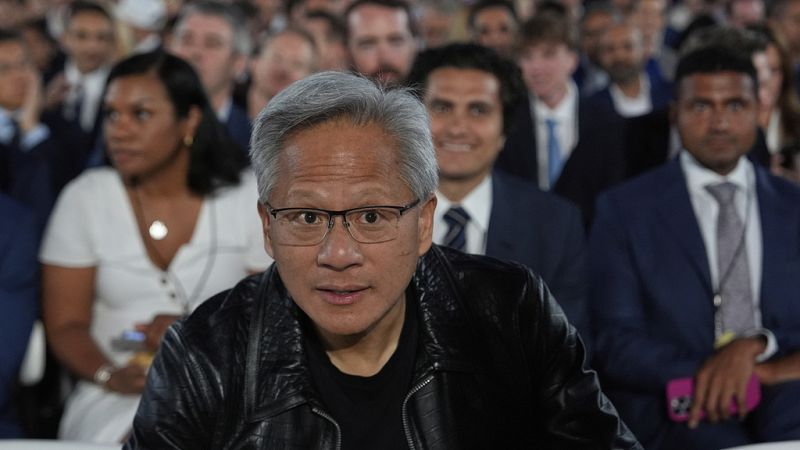Nvidia AI chips sales rise but so do fears of an AI bubble bursting

Nvidia's shares slid after the AI semiconductor giant reported its latest quarterly profit and gave a revenue forecast that was slightly below expectations in its latest earnings report.
Demand for the company's chips, an essential part of AI data centres, wasn't quite feverish enough to ease recent worries that the AI craze may be fading.
The results announced on Wednesday were hotly anticipated because Nvidia has emerged as a key barometer of a two-year-old AI boom that has been propelling the stock market to new heights.
The Silicon Valley chipmaker also became the first publicly traded company to achieve a $4tr (€3.44tr) market capitalisation, surpassing the value of the German stock market.
In recent weeks, though, research reports and comments by prominent tech executives have raised investor fears that the AI mania has been overblown.
More than 50% increase in sales is not enough to calm nerves
In the May-July period, Nvidia's data centre division posted revenue of $41.1bn (€35.3bn), a 56% increase on the same time last year, but below analysts' forecast of $41.3bn (€35.48bn), according to FactSet Research.
Even so, Nvidia's profit of $26.4bn (€22.68bn), or $1.08 per share, was higher than analysts predicted, as was its total revenue of $46.7bn (€40.1bn) — also a 56% increase on the previous year.
Nvidia signalled it believes more good things are still to come by forecasting revenue of $54bn (€46.4bn) for the August-October period, slightly above what analysts had been envisioning for the quarter.
"We are in the beginning of the buildout," Nvidia CEO Jensen Huang told analysts during a Wednesday conference call where the company predicted another $3tr to $4tr will be spent on AI initiatives by the end of this decade.
But Nvidia's stock still slipped 3% in extended trading after the fiscal second quarter report came out, indicating the performance wasn't enough to allay investors' fears. A letdown was almost inevitable, given that the stock price has increased by more than tenfold during the past two and a half years.
"Saying the stock was priced for perfection would be an enormous understatement," said Investing.com analyst Thomas Monteiro.
Delivering the kind of growth to push Nvidia toward a $5tr (€4.3tr) market value has become more daunting as Nvidia's annual sales have ballooned from $44bn (€37.8bn) in its fiscal 2024 to a projected $204bn in the company's current fiscal year that ends in January.
That has translated into progressively slower rates of year-over-year revenue growth. After Nvidia's revenue at least doubled or tripled from the previous year in five consecutive quarters during 2023 and 2024, the growth has been tapering off over the past four quarters.
What the tariffs cost Nvidia's results
Nvidia would have fared better in the most recent quarter if President Donald Trump hadn't imposed a ban that prevented Nvidia from selling its AI chips in China during the quarter. But investors had already been forewarned that the restrictions would cost the company about $8bn (€6.87bn) in sales from May through July, so that challenge was already reflected in Nvidia's stock price.
Trump took the China handcuffs off of Nvidia earlier this month in return for a 15% cut of the company's sales in that country — a compromise that is expected to help boost revenue during the upcoming months, although it's unclear how quickly that will happen.
In the best-case scenario, Nvidia may be able to bring in $2bn to $5bn (€1.7bn to €4.3bn) in AI chip sales to China, according to Colette Kress, the company's chief financial officer.
While the technology industry has been the biggest beneficiary of the AI frenzy, it has also been a boon for the overall stock market. The benchmark S&P 500 has gained 69% since the end of 2022, with AI fervour fueling much of the investor optimism.
But even amid the general euphoria, there have recently been murmurs about whether AI mania will prove to be an echo of the late 1990s dot-com boom and meltdown that plunged Silicon Valley into a funk that lasted several years.
Today

